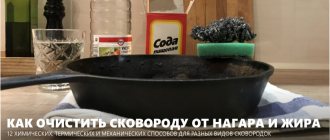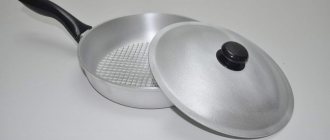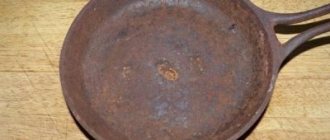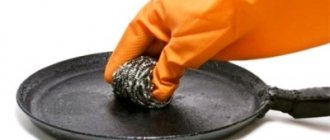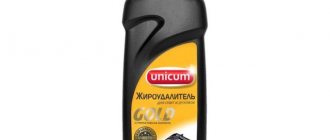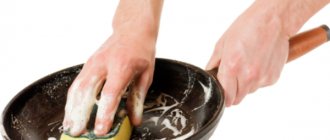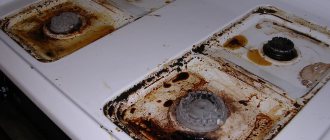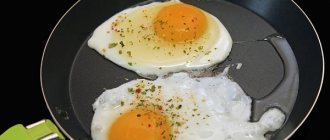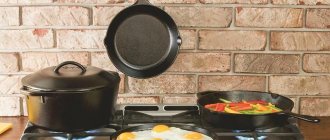In this article you will learn useful information about cleaning pans with different coatings. And also about how to remove fumes and rust using traditional methods.
Even the most careful cooks still have grease and soot in the pan, especially if the leftover food is not washed off immediately, a thick layer of soot will form. Removing greasy deposits is a rather unpleasant and painstaking job, but if you devote a little time and effort, even the blackest frying pan can be washed with various folk remedies that can be found in every kitchen.
But if you don’t take any measures, then you can soon completely forget about the impeccable appearance of your new frying pan.
But the worst thing is that this fume has a negative impact on human health. The ingrained fat can lead to various gastrointestinal diseases and even leads to the development of cancer.
How to clean a ceramic frying pan from carbon deposits: folk recipes, tips
Food cooked in a frying pan with a ceramic surface rarely burns. But if fumes do form, then you should wash such utensils as carefully as possible. In order to avoid microcracks, it is necessary to avoid contact with cold water, and also to avoid sudden temperature changes. At the same time, it is worth remembering that the above methods, which are suitable for cast iron frying pans, absolutely cannot be used for such a “delicate” surface.
Place 5 tbsp on the ceramic surface. Heat the salt well. Then carefully wash off the contents using a washcloth and detergent. Then, wipe dry with a soft cloth or paper towel.
You can also clean the resulting “coat” on the outside of the frying pan mechanically; for this you should use an attachment in the form of a wire brush for metal for an angle grinder and, of course, do not forget about protection - goggles, a respiratory mask and gloves. Cleaning in this way must be done as carefully and carefully as possible. Thanks to this method, you can clean the pan until it shines, but it is only suitable for the outside of the surface .
If food starts to stick after cleaning, you can heat it with vegetable oil or a little kitchen salt. The salt should be heated in a frying pan for 20 minutes, as soon as it starts to “crackle”, mix well. For a similar procedure, this salt can be used again.
How to clean rust from a frying pan?
To get rid of rust on a frying pan you need:
- Clean the pan using any method used to remove the layer of fat described above.
- Dry the utensils well
- Place in a preheated oven at 120°C for 40 minutes.
- Take out the frying pan, grease it with vegetable oil, and cover the bottom with foil
- Heat the oven to 230 °C and place the frying pan for 1 hour
- Then, take it out and grease it again with a small amount of vegetable oil.
Keep the pans clean
After this procedure, food should not stick to the surface.
- Regular sand and raw potatoes, which you should rub on the damaged areas, will help you get rid of rust.
- A burnt frying pan can be saved by boiling in a bucket with the addition of 2-3 onions and 3 tsp. baking soda.
Aluminum pans should be washed as usual. First, use regular detergents and cleaning powder, then rinse well. Immediately after cooking, while the pan is still warm, you can rub the outside of the pan with coarse salt to avoid the formation of a thick “coat.”
What can't be done and why?
The rule of three “no” will help to efficiently clean the frying pan from carbon deposits, while maintaining its beneficial qualities:
- No metal sponges and brushes (they leave scratches and erase the protective non-stick layer).
- No abrasive powders (allowed only for cast iron products). Abrasives wear down the top layer of the pan, causing food to stick to the surface.
- No sudden temperature changes. Do not suddenly lower a hot frying pan into cold water. Stressful temperature changes destroy the protective layer, causing the frying pan to become unusable faster.
Sources
- https://kakchistim.ru/chistota-doma/skovorody-i-kastryuli/kak-ochistit-skovorodu-ot-nagara-25-luchshix-sposobov.html
- https://posudaguide.ru/chistka-i-uhod/ochishhenie-skovorodki-ot-chernogo-nagara-bystro-v-domashnih-usloviyah
- https://dezinfecc.ru/primenenie/kak-pochistit-skovorodu-ot-nagara
- https://KatalogPoleznogo.ru/dom/nagar-na-skovorode-pochistim-snaruzhi-i-vnutri.html
- https://Trizio.ru/kak-ochistit-skovorodu-ot-nagara-1016
- https://chistsovet.ru/chistka/kak-pochistit-skovorodu-ot-nagara-i-zhira/
- https://DomStrouSam.ru/%F0%9F%9A%A9-kak-ochistit-skovorodu/
- https://sdelai-lestnicu.ru/uborka/kak-ocistit-skovorodu-ot-nagara-30-sposobov-v-domasnih-usloviah
- https://berkem.ru/posuda/kak-pochistit-skovorodu/
- https://kitchendizajn.ru/kak-ochistit-skovorodku-ot-zhira/
- https://you.cleaning/chistka/kak-ochistit-skovorodu-ot-zastarelogo-nagara
- https://hozzi.ru/chistka/skovorody-ot-nagara
- https://you.cleaning/chistka/kak-ochistit-skovorodu-ot-nagara
- https://atvmedia.ru/materials/kak-ochistit-skovorodu
- https://yborka.online/uborka/nagar/skovorodka
Did the article help? Rate it
What is suitable for cleaning the device from burnt oil from the outside
To clean the outside, use alcohol, gel and spray. A dishwasher will also help with this. Carbon deposits can be cleaned off using a special sponge. Always take into account that the coating is vulnerable to hard materials. You should also avoid washing the pan with abrasive materials.
Poor quality water causes scale to form on ceramic dishes.
Security measures
Any cleaning involves aggressive action using mechanical techniques and chemical reagents, so be sure to take care of safety:
- When working, use thick rubber gloves. If they break during the process, immediately replace them with new ones, after washing your hands.
- Wear a respirator or a multi-layer gauze bandage to protect your respiratory system.
- Provide fresh air. You can open windows and doors to create a draft.
- Restrict access to the kitchen for children and pets. They may inhale toxic fumes or spill hot solution on themselves.
- Before cleaning, remove the handle from the pan if it is made of plastic or wood.
- After processing, rinse the dishes thoroughly. It would be a good idea to boil it in clean water to ensure that any remaining particles of burnt particles and chemicals are removed.
Household chemicals for removing carbon deposits
" Domestos" is a chlorine-containing substance that can remove even the most stubborn stains. Important: cannot be used for frying pans with Teflon or non-stick coating.
" Unicum Gold" is a special product for removing fatty stains. Cannot be used on aluminum pans.
"Mr. Muscle" is an effective household chemical against grease and dirt. With its help, you can easily clean the frying pan from carbon deposits.
" Cilit" is a powerful remedy against old greasy stains.
Important: Take safety precautions when working. Wear rubber gloves and a respirator to avoid damaging the skin of your hands and mucous membranes.
Features of cleaning pans made of different materials
Frying pans come in cast iron, steel and aluminum with or without non-stick coating. For each material there are recommendations on how to properly clean it.
Features of cleaning various pans:
| Material/type of pan coating | Features of carbon deposits cleaning | Contraindications |
| Teflon (Tefal) | You can clean tefal pans with neutral or alkaline dish gels. | Does not tolerate overheating, sudden cooling, abrasives |
| Cast iron without coating | Abrasive products will clean well | Acids cause rust |
| Coated cast iron (grill cookware and pancake pan) | Carbon deposits are washed off with fat-dissolving chemicals | A cast iron frying pan cannot be cleaned with metal utensils. |
| Ceramic | It is better to clean household chemicals with a neutral pH and solutions with alcohol or hydrochloric acid | Do not sharply cool or tap. Products with acid, chlorine, alkali are contraindicated |
| Titanium | The coating is scratch resistant. You can clean a non-stick frying pan with any household dishwashing chemical. | It is not recommended to remove carbon deposits with dry soda, sand, or other abrasives. |
| Steel without coating | The carbon deposits will be cleaned with a gel, a product with glue, vinegar, lemon, ammonia, soda, mustard | Contaminants cannot be removed with chlorides and acidic chemicals |
| Aluminum and duralumin without coating | It is better to clean with neutral products without abrasive particles. | An aluminum frying pan cannot be treated with acid-containing chemicals or metal utensils. |
| Marble or granite | It is better to clean carbon deposits using products in the form of foam, solution, cream, paste | It is forbidden to cool a stone frying pan sharply or wash it with powder or abrasive sponges. |
| Pancake maker with non-stick coating | A solution with a neutral pH will clean the pancake pan. | Use products designed to care for this material. |
Carbon deposits from pans made of aluminum, duralumin and on the non-stick side must not be removed with metal products. It is better to clean it with synthetic tools and non-abrasive products after it has cooled at room temperature.
Melamine sponge
This cleaning method is suitable for any frying pan. However, a melamine sponge is unlikely to cope with a thick, dense layer of burnt marks. Before working, do not forget to wear rubber gloves, as the substances contained in the sponge can damage the skin of your hands.
The method of use is simple - take a sponge and scrub the inside and outside of the pan. Grease, burnt marks and rust will come off very well. It should be noted that after removing burnt marks using a melamine sponge, the pan must be washed very well with hot water and rinsed thoroughly.
How to clean a Teflon non-stick frying pan?
The Teflon coating should protect against various contaminants and soot, as well as against food sticking to the surface, but unfortunately, due to improper use, it is very difficult to avoid the formation of soot and grease in the frying pan. Therefore, before you start directly preparing the dish, you need to read the instructions and rules for using kitchen utensils.
These pans are ideal for cooking, but only if you use them correctly. It is worth remembering that such pans should not be scratched, metal spatulas should not be used, and they should not be heated too much. But you need to clean Teflon utensils very carefully.
The non-stick coating will not be damaged when washed if you use this method:
- Mix 200 g of dishwashing detergent, 3 tbsp. baking soda and 3 liters of water
- Boil the frying pan in this solution for 30 minutes.
Set the dishwasher to maximum mode and wash the kitchen utensils 2-3 times, then there will be no harm to the coating, and most importantly, you can get rid of burnt fat without much difficulty.
It is quite easy to wash off light burnt from such a frying pan; to do this, you just need to pour water to the very edges, add a few tablespoons of citric acid and let it heat up. As soon as the solution boils, wash off all remaining “peel” with a regular dishwashing sponge.
Cleaning a Teflon frying pan
Instead of citric acid, you can use regular baking soda - 3 tbsp. soda, pour boiling water and let simmer for 5-10 minutes. The contents are easily washed off under running water. You can use baking powder rather than baking soda; 1 sachet is enough for one frying pan. Rinse off with a sponge under running water. Baking powder has a more gentle effect on the surface, even if the first time it was not possible to get rid of all the plaque, you can repeat the procedure.
Apple juice will help you get rid of some fat. It is worth cutting the fruit into two parts, cutting half of the apple with a knife so that it releases the juice, and rub the frying pan with this part, let it stand for 15 minutes. A small amount of apple cider vinegar will also work. You can moisten a washcloth and rub the pan, also leave it for a while, and then rinse with washing gel.
But if you don’t wash the frying pan for a long time, a very thick layer of fat and scale will form. It is worth remembering that, unlike cast iron frying pans, the Teflon coating does not tolerate cleaning powder, salt and brushes with a rough surface, so it is better to use the following products:
- Coca-Cola, which should be heated in a frying pan, is brought to a boil. Next, wash as usual after the drink has cooled. If all the fumes have not peeled off from the walls the first time, the procedure can be repeated several times until all the fumes have disappeared.
- You can also rub the surface with regular toothpaste and let it sit. Tooth powder should not be used in this case.
- The carbon deposits will quickly disappear if you rub the frying pan with ethyl alcohol .
A large amount of old fat, which is difficult to wash off with a regular washcloth, can be removed as follows:
- For 7 liters of water, take 100 g of soda and 200 ml of glue (stationery). Mix well and immerse a Teflon frying pan in the solution for 24 hours. The fat should peel off in this solution, then wash the surface in the usual way.
- Grate 1 bar of soap into a bucket and add 200 g of soda, lower the utensils and boil for 2 hours.
- For 3 liters of water, take 200 g of washing liquid, 50 g of glue and 200 g of soda. Immerse the pan in this solution for 2 days. You should only rinse with hot water, but you should increase the temperature gradually so as not to lead to the formation of cracks. Cold water is absolutely not suitable; most likely, a small layer of fat will remain in the pan. Worst of all, it will ruin the pan completely.
The outer side of such a frying pan can be washed in any way, because... it has nothing to do with food, and also does not have a special coating, and does not affect the quality of cooking in the future. And for cleaning you can use iron brushes, powders, pastes, salt and sand. The main thing is to prevent these products and devices from getting on the inside.
Keeping the pans clean
In order to preserve the Teflon coating as much as possible, before using any method, you should try soaking the pan in plain water overnight. These pans are convenient because food residues very rarely stick to them, but if this happens, it is also very easy to clean if you start the procedure right away.
Despite the fact that the Teflon surface is quite delicate, washing it is not very difficult if you follow all the rules. If you have to wash utensils too often, it is better to change the frying pan, because this indicates that the surface is already damaged and it is highly undesirable to use it.
Fat and food particles that remain after cooking are sometimes quite difficult to wash off, especially if you do not do it on time. If ordinary cast iron frying pans can be washed in a variety of ways, then utensils with a non-stick coating should be cleaned with extreme caution so as not to spoil the protective layer.
Under no circumstances should such a frying pan be subjected to physical manipulation or exposure to strong acids and alkalis. Therefore, you need to act very carefully, and it is better not to expose the frying pan to chemicals again; you should use proven folk methods. Frequent use of aggressive agents can lead to damage to such a surface, and the frying pan will no longer be suitable for use.
Prevents combustion
To begin with, you should try to wash off the resulting fumes with regular boiling water. To do this, fill the pan to the top and let stand until the water cools. Then, wash with warm water with the addition of washing gel.
If you still can’t get rid of the burning, you should take other measures.
- To clean the inside of the frying pan, you should use products with reduced toxicity. Soap is one of these products. In order to clean the utensils, dissolve 1 piece of soap in 5 liters of water and lower the frying pan into it. Then boil and let sit for 3 hours, then wash as usual.
- Dilute 5 tbsp. soda in 1 liter of water. Lower the pan and boil for 30 minutes. After this, cool the solution and wash the pan with a regular kitchen sponge.
- Place the utensils in a bucket of water, add 1 tube of office glue and 1/3 of a bag of soda. Boil for an hour. Then let it brew for a day. Next, wash as usual.
- In exactly the same way, you should boil a frying pan with detergent (200 ml of detergent is enough for 5 liters of water). After the frying pan has been set, it should be thoroughly rinsed under running water and then boiled for 40 minutes. in clean water.
Various means are suitable for cleaning the outside of the frying pan, but only if they do not get inside. Various sprays and cleaning powders can be used. The basic principle of their use is that any product must be applied to the surface and left for a while, then rinsed off in the usual way.
But before resorting to such radical solutions, it’s worth trying regular boiling, which will help clean the frying pan from the “fur coat” on the outer walls. Various available products will help speed up the process, but regular laundry soap or liquid dishwashing detergent is best.
Keeping the assistant clean
It is important to remember a few rules:
- Do not use metal utensils for cooking; it is better to use wooden or silicone material.
- The inside should be washed every time after use, and the outside should be washed 1-2 times a week.
- If a layer of burning remains after each cooking, then such a frying pan should be thrown away.
- If burns form after cooking certain dishes, then they should not be cooked in this frying pan.
- Do not heat the cookware above 250 °C. At this temperature, the protective layer and the integrity of the coating are destroyed. And it will be much more difficult to wash the pan.
